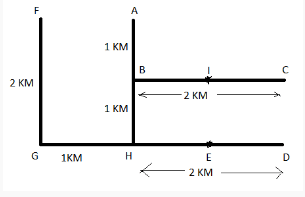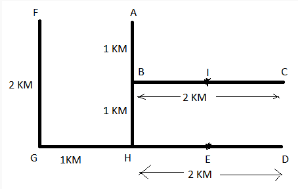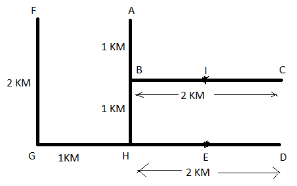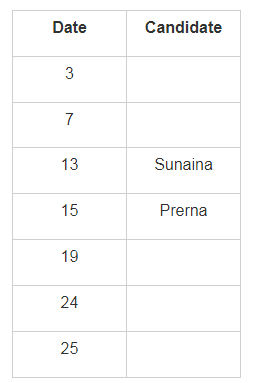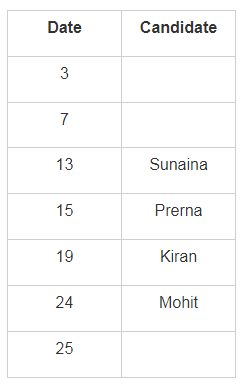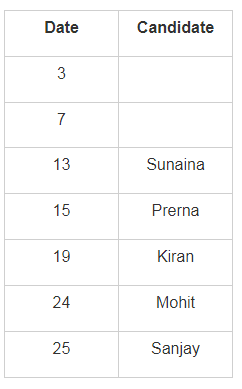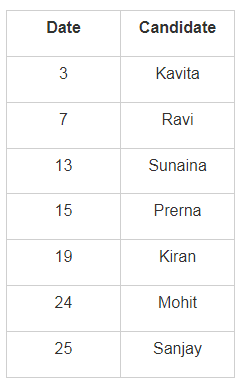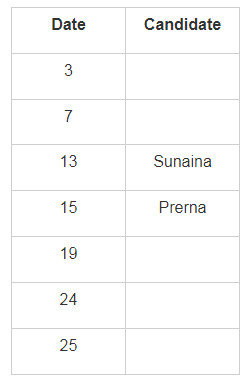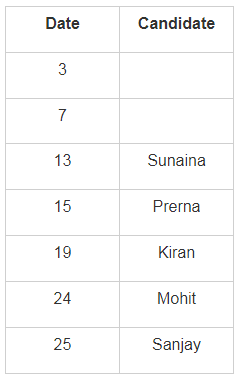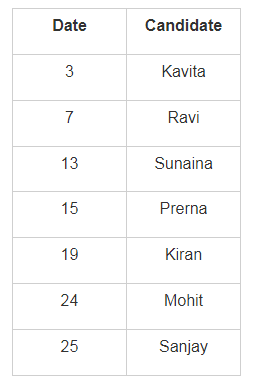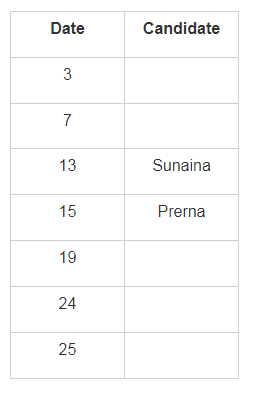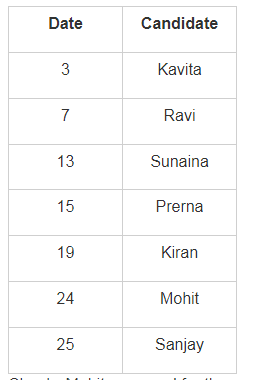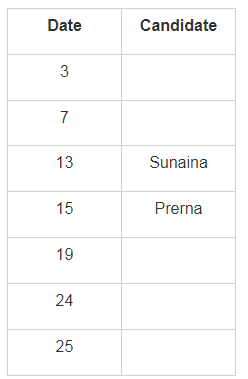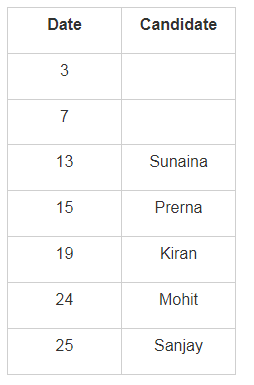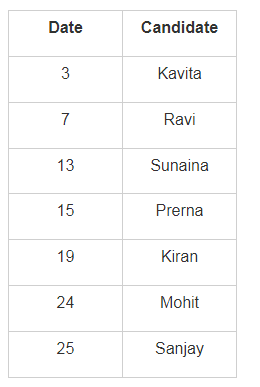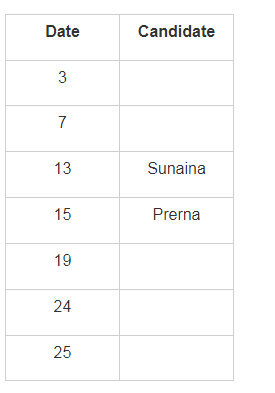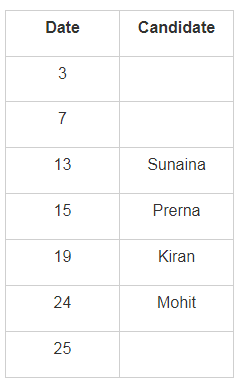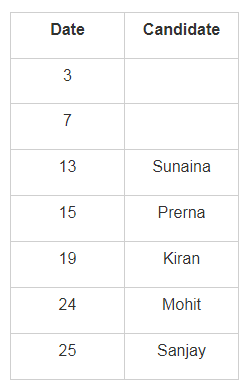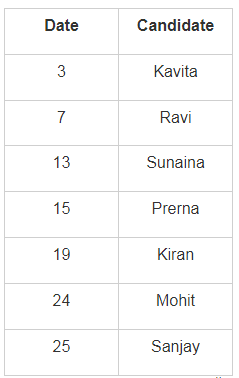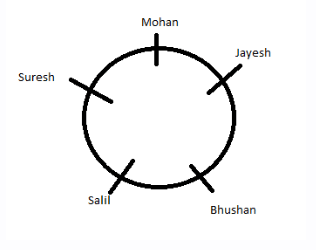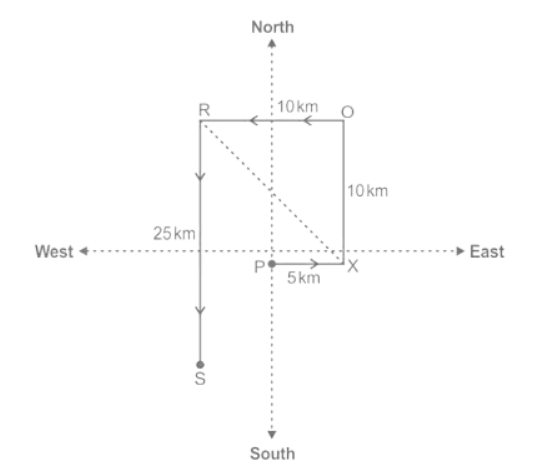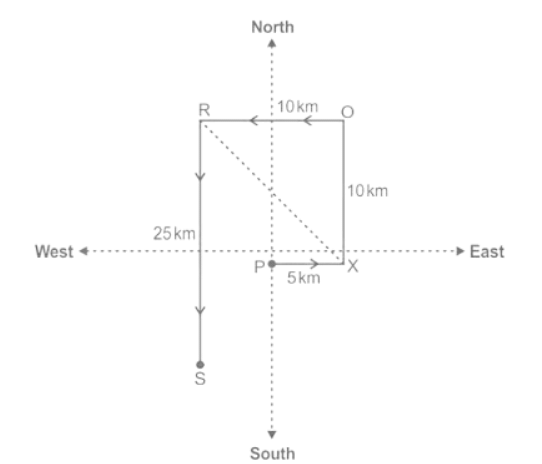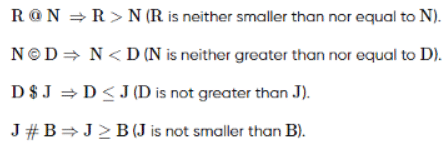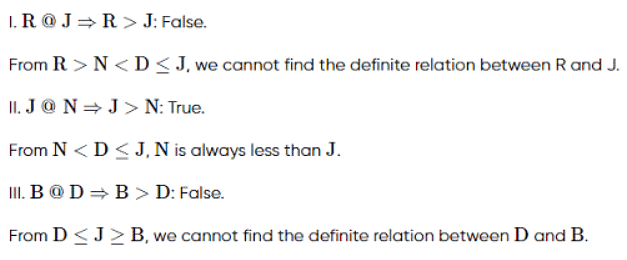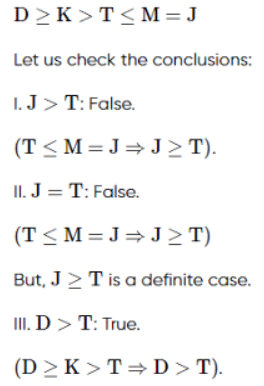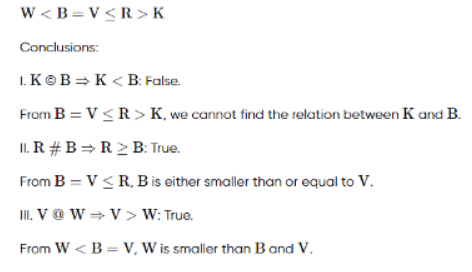IBPS RRB Clerk Prelims Mock Test - 8 - Bank Exams MCQ
30 Questions MCQ Test - IBPS RRB Clerk Prelims Mock Test - 8
Study the information given below carefully and answer the questions that follow:
A, B, C, D, E, F, G, H and I are nine houses. C is 2 km East of B. A is 1 km North of B and H is 2 km South of A. G is 1 km West of H while D is 3 km East of G and F is 2 km North of G. I is situated just in middle of B and C while E is just in middle of H and D.
Q. Distance between A and F is?
Study the information given below carefully and answer the questions that follow:
A, B, C, D, E, F, G, H and I are nine houses. C is 2 km East of B. A is 1 km North of B and H is 2 km South of A. G is 1 km West of H while D is 3 km East of G and F is 2 km North of G. I is situated just in middle of B and C while E is just in middle of H and D.
Q. Distance between E and I is?
Study the information given below carefully and answer the questions that follow:
A, B, C, D, E, F, G, H and I are nine houses. C is 2 km East of B. A is 1 km North of B and H is 2 km South of A. G is 1 km West of H while D is 3 km East of G and F is 2 km North of G. I is situated just in middle of B and C while E is just in middle of H and D.
Q. Distance between E and G is?
Direction: Read the following information carefully and answer the questions that follow:
Seven friends, Kiran, Sanjay, Ravi, Sunaina, Kavita, Prerna, and Mohit registered for the SSC CHSL exam together. Their exam was conducted on seven different dates of the same month viz. 3, 7, 13, 15, 19, 24, and 25. Ravi appeared for the exam after Kavita. Prerna appeared for the exam two days after Sunaina. At least five people appeared for the exam before Sanjay. Kiran appeared for the exam five days before Mohit.
Q. Sunaina appeared for the exam on which day of the month?
Direction: Read the following information carefully and answer the questions that follow:
Seven friends, Kiran, Sanjay, Ravi, Sunaina, Kavita, Prerna, and Mohit registered for the SSC CHSL exam together. Their exam was conducted on seven different dates of the same month viz. 3, 7, 13, 15, 19, 24, and 25. Ravi appeared for the exam after Kavita. Prerna appeared for the exam two days after Sunaina. At least five people appeared for the exam before Sanjay. Kiran appeared for the exam five days before Mohit.
Q. How many people appeared for the test before Mohit?
Direction: Read the following information carefully and answer the questions that follow:
Seven friends, Kiran, Sanjay, Ravi, Sunaina, Kavita, Prerna, and Mohit registered for the SSC CHSL exam together. Their exam was conducted on seven different dates of the same month viz. 3, 7, 13, 15, 19, 24, and 25. Ravi appeared for the exam after Kavita. Prerna appeared for the exam two days after Sunaina. At least five people appeared for the exam before Sanjay. Kiran appeared for the exam five days before Mohit.
Q. Who appeared for the exam on 24th of the month?
Direction: Read the following information carefully and answer the questions that follow:
Seven friends, Kiran, Sanjay, Ravi, Sunaina, Kavita, Prerna, and Mohit registered for the SSC CHSL exam together. Their exam was conducted on seven different dates of the same month viz. 3, 7, 13, 15, 19, 24, and 25. Ravi appeared for the exam after Kavita. Prerna appeared for the exam two days after Sunaina. At least five people appeared for the exam before Sanjay. Kiran appeared for the exam five days before Mohit.
Q. Who appeared for the test on the 19th of the month?
Direction: Read the following information carefully and answer the questions that follow:
Seven friends, Kiran, Sanjay, Ravi, Sunaina, Kavita, Prerna, and Mohit registered for the SSC CHSL exam together. Their exam was conducted on seven different dates of the same month viz. 3, 7, 13, 15, 19, 24, and 25. Ravi appeared for the exam after Kavita. Prerna appeared for the exam two days after Sunaina. At least five people appeared for the exam before Sanjay. Kiran appeared for the exam five days before Mohit.
Q. Which of the following is matched correctly?
Each of the questions below consists of a question and two statements numbered I and II given below it. You have to decide whether the data provided in the statements is sufficient to answer the question. Read both the statements and give answers.
How is N related to K?
I. N's brother is married to D.
II. D's sister is married to K.
Each of the questions below consists of a question and two statements numbered I and II given below it. You have to decide whether the data provided in the statements is sufficient to answer the question. Read both the statements and give answers.
How is 'over' written in a code language?
I. 'Over and again' is written as 'Ka ja ha' in that code language.
II. 'Come and go' is written as 'ja pa na' in that code language.
Each of the questions below consists of a question and two statements numbered I and II given below it. You have to decide whether the data provided in the statements is sufficient to answer the question. Read both the statements and give answers.
Who among M, T, K, J and R is the shortest but one?
I. T is taller than J and R.
II. K is shorter than R and M.
Each of the questions below consists of a question and two statements numbered I and II given below it. You have to decide whether the data provided in the statements is sufficient to answer the question. Read both the statements and give answers.
How many sisters does P have?
I. T and V are the only sisters of D.
II. D is brother of P.
Each of the questions below consists of a question and two statements numbered I and II given below it. You have to decide whether the data provided in the statements is sufficient to answer the question. Read both the statements and give answers.
Who is the immediate right of Mohan when Mohan, Salil, Bhushan, Suresh and Jayesh are sitting around a circle facing the centre?
I. Salil is third to the left of Mohan.
II. Bhushan is between Salil and Jayesh.
Directions: Study the information given below carefully and answer the questions that follow.
Shubh starts walking from point P and moves 5 km toward the east to reach point X. Now he moves 10 km towards the north and reaches Q. Then he moves 10 km towards the west to reach R, and finally he moves 25 km towards the south to reach his destination S.
Q. In which direction is S with respect to X?
Directions: Study the information given below carefully and answer the questions that follow.
Shubh starts walking from point P and moves 5 km toward the east to reach point X. Now he moves 10 km towards the north and reaches Q. Then he moves 10 km towards the west to reach R, and finally he moves 25 km towards the south to reach his destination S.
Q. What is the shortest distance between X and R?
Directions: Study the information given below carefully and answer the questions that follow.
Shubh starts walking from point P and moves 5 km toward the east to reach point X. Now he moves 10 km towards the north and reaches Q. Then he moves 10 km towards the west to reach R, and finally he moves 25 km towards the south to reach his destination S.
Q. In what direction is point Q with respect to R?
In the following questions, the symbols @, ©, $, % and # are used with the following meanings as illustrated below.
'P $ Q' means 'P is not greater than Q'.
'P @ Q' means 'P is neither smaller than nor equal to Q'.
'P # Q' means 'P is not smaller than Q'.
'P © Q' means 'P is neither greater than nor equal to Q’.
'P % Q' means 'P is neither smaller than nor greater than Q’.
Now in each of the following questions assuming the given statements to be true, find out which of the three conclusions I, II and III given below them is/are definitely true and give your answer accordingly.
Statements: H $ M, M # T, T @ D, D © R
Conclusions:
I. D © M
II. R @ M
III. H $ T
In the following questions, the symbols @, ©, $, % and # are used with the following meanings as illustrated below.
'P $ Q' means 'P is not greater than Q'.
'P @ Q' means 'P is neither smaller than nor equal to Q'.
'P # Q' means 'P is not smaller than Q'.
'P © Q' means 'P is neither greater than nor equal to Q’.
'P % Q' means 'P is neither smaller than nor greater than Q’.
Now in each of the following questions assuming the given statements to be true, find out which of the three conclusions I, II and III given below them is/are definitely true and give your answer accordingly.
Statements: R @ N, N © D, D $ J, J # B
Conclusions:
I. R @ J
II. J @ N
III. B @ D
In the following questions, the symbols @, ©, $, % and # are used with the following meanings as illustrated below.
'P $ Q' means 'P is not greater than Q'.
'P @ Q' means 'P is neither smaller than nor equal to Q'.
'P # Q' means 'P is not smaller than Q'.
'P © Q' means 'P is neither greater than nor equal to Q’.
'P % Q' means 'P is neither smaller than nor greater than Q’.
Now in each of the following questions assuming the given statements to be true, find out which of the three conclusions I, II and III given below them is/are definitely true and give your answer accordingly.
Statements: B % J, J @ K, K © T, T $ F
Conclusions:
I. F @ K
II. B @ K
III. B @ F
In the following questions, the symbols @, ©, $, % and # are used with the following meanings as illustrated below.
'P $ Q' means 'P is not greater than Q'.
'P @ Q' means 'P is neither smaller than nor equal to Q'.
'P # Q' means 'P is not smaller than Q'.
'P © Q' means 'P is neither greater than nor equal to Q’.
'P % Q' means 'P is neither smaller than nor greater than Q’.
Now in each of the following questions assuming the given statements to be true, find out which of the three conclusions I, II and III given below them is/are definitely true and give your answer accordingly.
Statements: D # K, K @ T, T $ M, M % J
Conclusions:
I. J @ T
II. J % T
III. D @ T
In the following questions, the symbols @, ©, $, % and # are used with the following meanings as illustrated below.
'P $ Q' means 'P is not greater than Q'.
'P @ Q' means 'P is neither smaller than nor equal to Q'.
'P # Q' means 'P is not smaller than Q'.
'P © Q' means 'P is neither greater than nor equal to Q’.
'P % Q' means 'P is neither smaller than nor greater than Q’.
Now in each of the following questions assuming the given statements to be true, find out which of the three conclusions I, II and III given below them is/are definitely true and give your answer accordingly.
Statements: W © B, B % V, V $ R, R @ K
Conclusions:
I. K © B
II. R # B
III. V @ W
Directions: Read the following information carefully and answer the question that follow.
Six persons A, B, C, D, E, and F are comparing their weights and each of them is having a different weight. D is heavier than only two persons. E is the person heavier than F and lighter than D. C's weight is less than only B's weight.
Q. Who has weight less than D?
Directions: Read the following information carefully and answer the question that follow.
Six persons A, B, C, D, E, and F are comparing their weights and each of them is having a different weight. D is heavier than only two persons. E is the person heavier than F and lighter than D. C's weight is less than only B's weight.
Q. Who is third heaviest?
Directions: Read the following information carefully and answer the question that follow.
Six persons A, B, C, D, E, and F are comparing their weights and each of them is having a different weight. D is heavier than only two persons. E is the person heavier than F and lighter than D. C's weight is less than only B's weight.
Q. How many persons are heavier than A?
In each question given below, a group of letters followed by four combinations of digits/symbols is given. You have to find out which combination correctly represents the group of letters based on the following coding system and conditions and mark the number of that combination as the answer. If none of the four combinations correctly represents the group of letters, then mark 'None of these' as your answer.
![]()
Conditions:
(A) If the first element in the group is an even number and the last element is a symbol, both these are to be coded as the code for symbol.
(B) If the first element in the group is an odd digit and the last element is an even digit, their codes are to be interchanged.
(C) If both the first and last elements of the group are symbols, then both of these are to be coded as 'X'.
387#©9
In each question given below, a group of letters followed by four combinations of digits/symbols is given. You have to find out which combination correctly represents the group of letters based on the following coding system and conditions and mark the number of that combination as the answer. If none of the four combinations correctly represents the group of letters, then mark 'None of these' as your answer.
![]()
Conditions:
(A) If the first element in the group is an even number and the last element is a symbol, both these are to be coded as the code for symbol.
(B) If the first element in the group is an odd digit and the last element is an even digit, their codes are to be interchanged.
(C) If both the first and last elements of the group are symbols, then both of these are to be coded as 'X'.
9124δ6
In each question given below, a group of letters followed by four combinations of digits/symbols is given. You have to find out which combination correctly represents the group of letters based on the following coding system and conditions and mark the number of that combination as the answer. If none of the four combinations correctly represents the group of letters, then mark 'None of these' as your answer.
![]()
Conditions:
(A) If the first element in the group is an even number and the last element is a symbol, both these are to be coded as the code for symbol.
(B) If the first element in the group is an odd digit and the last element is an even digit, their codes are to be interchanged.
(C) If both the first and last elements of the group are symbols, then both of these are to be coded as 'X'.
@91$26
In each question given below, a group of letters followed by four combinations of digits/symbols is given. You have to find out which combination correctly represents the group of letters based on the following coding system and conditions and mark the number of that combination as the answer. If none of the four combinations correctly represents the group of letters, then mark 'None of these' as your answer.
![]()
Conditions:
(A) If the first element in the group is an even number and the last element is a symbol, both these are to be coded as the code for symbol.
(B) If the first element in the group is an odd digit and the last element is an even digit, their codes are to be interchanged.
(C) If both the first and last elements of the group are symbols, then both of these are to be coded as 'X'.
4@312δ
In each question given below, a group of letters followed by four combinations of digits/symbols is given. You have to find out which combination correctly represents the group of letters based on the following coding system and conditions and mark the number of that combination as the answer. If none of the four combinations correctly represents the group of letters, then mark 'None of these' as your answer.
![]()
Conditions:
(A) If the first element in the group is an even number and the last element is a symbol, both these are to be coded as the code for symbol.
(B) If the first element in the group is an odd digit and the last element is an even digit, their codes are to be interchanged.
(C) If both the first and last elements of the group are symbols, then both of these are to be coded as 'X'.
%4187*
How many meaningful English words can be formed, starting with A, with the second, the third, the fifth, the ninth and tenth letters of the word PATHFINDER, using each letter only once in each word? (To be counted from left)


